Grain yield,nitrogen use efficiency and physiological performance of indica/japonica hybrid rice in response to various nitrogen rates
2023-01-06ZHOUQunYUANRuiZHANGWeiyangGUJunfeiLlULijunZHANGHaoWANGZhiqinYANGJianchang
ZHOU Qun,YUAN Rui,ZHANG Wei-yang,GU Jun-fei,LlU Li-jun,ZHANG Hao,WANG Zhi-qin,YANG Jian-chang
Jiangsu Key Laboratory of Crop Genetics and Physiology/Jiangsu Key Laboratory of Crop Cultivation and Physiology/Jiangsu Co-Innovation Center for Modern Production Technology of Grain Crops,College of Agriculture,Yangzhou University,Yangzhou 225009,P.R.China
Abstract Utilizing the heterosis of indica/japonica hybrid rice (IJHR) is an effective way to further increase rice grain yield.Rational application of nitrogen (N) fertilizer plays a very important role in using the heterosis of IJHR to achieve its great yield potential.However,the responses of the grain yield and N utilization of IJHR to N application rates and the underlying physiological mechanism remain elusive.The purpose of this study was to clarify these issues.Three rice cultivars currently used in rice production,an IJHR cultivar Yongyou 2640 (YY2640),a japonica cultivar Lianjing 7 (LJ-7) and an indica cultivar Yangdao 6 (YD-6),were grown in the field with six N rates (0,100,200,300,400,and 500 kg ha–1)in 2018 and 2019.The results showed that with the increase in N application rates,the grain yield of each test cultivar increased at first and then decreased,and the highest grain yield was at the N rate of 400 kg ha–1 for YY2640,with a grain yield of 13.4 t ha–1,and at 300 kg ha–1 for LJ-7 and YD-6,with grain yields of 9.4–10.6 t ha–1.The grain yield and N use efficiency (NUE) of YY2640 were higher than those of LJ-7 or YD-6 at the same N rate,especially at the higher N rates.When compared with LJ-7 or YD-6,YY2640 exhibited better physiological traits,including greater root oxidation activity and leaf photosynthetic rate,higher cytokinin content in the roots and leaves,and more remobilization of assimilates from the stem to the grain during grain filling.The results suggest that IJHR could attain both higher grain yield and higher NUE than inbred rice at either low or high N application rates.Improved shoot and root traits of the IJHR contribute to its higher grain yield and NUE,and a higher content of cytokinins in the IJHR plants plays a vital role in their responses to N application rates and also benefits other physiological processes.
Keywords: indica/japonica hybrid rice,grain yield,nitrogen use efficiency,cytokinins,non-structural carbohydrate,root activity
1.lntroduction
Rice (Oryza sativaL.) is one of the most important food crops in the world,providing nearly 60% of the dietary calories consumed by approximately 3 billion people(FAOSTAT 2019).Rice in China is the staple food for more than 65% of the population (Penget al.2009,2010).The rapid population growth and economic development need greater increases in food production,especially rice production (Zhang 2007;Penget al.2009;Ma and Yuan 2015).However,reports indicate a downward trend in the annual increase rate of rice yield in the world,and the rate of increase has even stagnated in some countries,such as in China (Penget al.2010;Grassiniet al.2013;Xuet al.2016).Due to the limitations of cultivation areas and water resources,the potential for increasing the rice planting area to increase the total yield is very limited,and therefore,it is necessary to increase the rice yield by increasing yield per unit area (Weiet al.2016).
To further increase yield potential,China has successfully bred “super” rice or “super” hybrid rice cultivars in the last 20 years by the use of intersubspecific heterosis combined with improvements in plant types(Chenget al.2007;Penget al.2008,2009;Ma and Yuan 2015).To date,146 “super” rice cultivars,including 92“super” hybrids,have been released with a growing area of more than 40 million hectares (Chenget al.2015;Cheng 2016;Zhang Het al.2021).Compared with non-super rice cultivars,super rice cultivars can increase grain yield by 15–20% in field experiments and by approximately 10%in large-area production (Zhanget al.2009;Ma and Yuan 2015;Huanget al.2016).To obtain a higher grain yield for a hybrid rice cultivar,a high nitrogen (N) rate is usually applied,which results in a low N use efficiency (NUE) (Xueet al.2013;Guet al.2017).Recently,anindica/japonicahybrid rice (IJHR) cultivar,Yongyou 2640 (YY2640),has been released and it has demonstrated a very high grain yield in the lower reaches of the Yangtze River in China(Menget al.2018;Zhuet al.2020).Several agronomic and physiological traits of the IJHR cultivar YY2640 have been documented,such as a larger sink size characterized by a greater number of spikelets per panicle (Huet al.2018;Zhanget al.2018),greater biomass accumulation and leaf area (Weiet al.2016,2017;Huet al.2018),and better root morphological architecture and physiological characteristics (Menget al.2018).Some reports show that a higher grain yield of the IJHR cultivar is usually obtained at a higher N application rate (Weiet al.2017;Huet al.2018;Zhanget al.2018).However,Huanget al.(2018) observed that hybrid rice,especially IJHR cultivars,exhibited higher yields over the inbred rice at low and moderate N rates.Obviously,it remains controversial whether the IJHR cultivars respond to N application rates.
Nitrogen is an essential nutrient for plant growth.The application of N fertilizer is a primary practice to increase rice grain yield (Liuet al.2015;Zhanget al.2015).However,over application of N fertilizer in rice production is a serious problem in China (Penget al.2010;Yanet al.2018;Zhang W Yet al.2021).Today the national average amount of N used in China’s rice production is about 180 kg ha–1,75% higher than the global average (Penget al.2010;Zhang Het al.2021).In some districts,such as the Taihu Lake area,the N application rate of rice is more than 270 kg ha–1(Grassiniet al.2013;Zhanget al.2018).Excessive application of N fertilizer can not only increase the loss of fertilizer-N,leading to environmental pollution (Hofmeieret al.2015;Lianget al.2017;Valliereet al.2017;Yanet al.2018),but also increase production cost and plant lodging risk and reduce NUE and grain quantity and quality (Dominiciet al.2014;Chenet al.2015;Roweet al.2015;Keskinenet al.2016).Although there are reports showing that many practices,such as using N-efficient rice cultivars (Zhuet al.2020),adoption of site-specific N management (Penget al.2010) or a higher proportion of N application at the late growth stage(Zhanget al.2018),and applying controlled/slow release N-fertilizer (Sunet al.2019;Zhang W Yet al.2021),can decrease N loss and increase NUE,little is known about whether and how a proper N application rate can synergistically increase grain yield and NUE in IJHR.
The objectives of this study were to: (1) compare the differences in the responses of yield formation to N application rates between IJHR and inbred rice cultivars,(2) understand the agronomic and physiological performances of IJHR under different N application rates,and (3) explore a rational N application rate to achieve both high grain yield and high NUE for IJHR.Some agronomic and physiological traits,including N uptake,leaf area duration (LAD),crop growth rate (CGR),leaf photosynthetic rate and net assimilation rate (NAR),non-structural carbohydrate (NSC) accumulation and remobilization in the stem,root biomass,root oxidation activity (ROA),and cytokinins (zeatin+zeatin riboside,Z+ZR) in roots were determined.This study will provide new insight into the mechanism underlying the response of IJHR to N application rates and synergistically increasing grain yield and NUE in rice.
2.Materials and methods
2.1.Plant materials and growing conditions
The field experiment was conducted at a research farm of Yangzhou University,Jiangsu Province,China (32°30´N,119°25´E) during the rice growing seasons (May–October)of 2018 and 2019.The soil in the field was a sandy loam(Typic Fluvaquent,Etisols) with 24.2 g kg–1organic matter,102 mg kg–1alkali hydrolysable N,34.1 mg kg–1Olsen-P,and 67.4 mg kg–1exchangeable K.The soil moisture content was 0.191 g g–1at field capacity.The soil bulk density was 1.30 g cm–3.The precipitation,solar radiation and mean temperature during the two rice growing seasons are shown in Appendix A.
Three rice (Oryza sativaL.) cultivars qualified by the Ministry of Agriculture and Rural Affair of China,Yongyou 2640(YY2640,anindica/japonicahybrid rice,IJHR),Lianjing 7(LJ-7,ajaponicainbred rice) and Yangdao 6 (YD-6,anindicainbred rice),were grown in the paddy field.YY2640 is a typical IJHR cultivar with greater heterosis in grain yield,stronger lodging-resistance,and wider adaptability (Menget al.2018;Zhuet al.2020;Liuet al.2021).Both inbred rice cultivars of LJ-7 and YD-6 are currently used in local production with large areas for their high yield and good quality (Wanget al.2016;Zhanget al.2020).Across the two study years,seeds were raised in the seedbed with a sowing date of 12 May and seedlings were transplanted on 11 June with a hill spacing of 15 cm×25 cm and two seedlings per hill.The three cultivars had similar growth durations from sowing to maturity,ranging from 155 to 157 d.The heading dates(50% of plants headed) of the three cultivars were on 13 August for YY2640 and 16 August for LJ-7 and YD-6 in 2018,and on 15 August for YY2640 and 18 August for LJ-7 and YD-6 in 2019.All plants were harvested from 15 to 17 October in both years.
2.2.Experimental design and treatments
The experiment was a 3×6 (three rice cultivars and six N application rates) factorial design with 18 treatment combinations.Each treatment had three plots as repetitions in a complete randomized block design.Plot dimensions were 4.5 m×5 m and plots were separated by a 1-m wide alley with plastic film inserted into the soil to a depth of 0.50 m to form a barrier.The six N rates included zero-N control (CK),100,200,300,400 and 500 kg ha–1.Urea as the N fertilizer was applied at the stages of pre-transplanting (1 day before transplanting),early tillering (7 days after transplanting),panicle initiation (the first appearance of differentiated apex),and spikelet initial differentiation (the appearance of glumous flower primordia at the tips of elongating primary rachis–branches) at a ratio of 4:2:2:2.Phosphorus(240 kg ha–1as single superphosphate) was applied before transplanting as basal fertilizer.Potassium(180 kg ha–1as KCl) was applied at the stages of pretransplanting and jointing at a ratio of 6:4.Weeds,insects,and diseases were controlled by either chemical or manual methods to avoid yield losses.Irrigation canals and ditches were made between the plots.Except for mid-season drainage,the field was kept at 2–3 cm water depth throughout the growth season until 1 week before the final harvest.
2.3.Sampling and measurements
The plants of five hills were sampled from each plot at the middle tillering (20 days after transplanting),panicle initiation (40–43 days after transplanting),the heading time (63–66 days after transplanting),and at maturity(125–128 days after transplanting) for measuring the shoot biomass.The sampled plants were separated into three components of leaves,stems,and panicles (the panicles were only determined at heading and maturity),and these separated samples were dried at 80°C for 72 h and then weighed.The contents of non-structural carbohydrate (NSC) in the stems and sheaths at heading and maturity were measured according to the method of Yoshidaet al.(1976).The sample was dried in an oven and ground into a fine powder.In a 15-mL centrifuge tube,100 mg of ground sample was added with 10 mL of ethanol (density 630 g L–1) and kept in a water bath at 80°C for 30 min.The tube was then centrifuged at 2 000 r min–1for 20 min after cooling.The supernatant was collected and the extraction was repeated three times.The alcohol in the supernatant was evaporated on a water bath at 80°C until most of the alcohol was removed and the volume was reduced to about 3 mL.The sugar extract was then diluted to 25 mL with distilled water.The concentration of sugars in the extract was then analyzed as described by Yoshidaet al.(1976).
The residue left in the centrifuge tube was dried at 80°C for starch extraction.A total of 2 mL of distilled water was added to the tube containing the dried residue.The tube was then shaken in a boiling water bath for 15 min.A total of 2 mL of 9.36 mol L–1HClO4was added to the tube after cooling.The solution was shaken for 15 min.The extract was then made up to about 10 mL and centrifuged at 2 000 r min–1for 20 min.The supernatant was collected and a further 2 mL of 4.68 mol L–1HClO4was added to the residue.The extraction was repeated as above.The supernatants were combined and made up to 50 mL with distilled water.The starch was analyzed by the method of Yoshidaet al.(1976).Leaf area was measured by using a leaf area meter (LI-3000C,Li-Cor;Lincoln,NE,USA).The crop growth rate (CGR),leaf area duration (LAD),and net assimilation rate (NAR) were calculated using the following formulas:

whereW1andW2andLAI1andLAI2indicate the shoot biomass (dry weight) and leaf area measured at the first (t1)and the second measurement times (t2),respectively.
The net photosynthetic rate of leaves and cytokinins(zeatin+zeatin riboside,Z+ZR) in leaves were measured at panicle initiation,heading time,and at the stages of early grain filling (11–12 days after heading (DAH)),mid grain filling (23–24 DAH),and late grain filling (35–36 DAH).The measurement of leaf photosynthetic rate was made by using a gas exchange analyzer (Li-Cor 6400 portable photosynthesis measurement system,Li-Cor,Lincoln,NE,USA) at 9:00–11:00 h in the morning,when the photosynthetically active radiation above the canopy was 1 300–1 500 μmol m–2s–1,with six leaves for each treatment.The extraction and determination of Z+ZR in leaves were made according to the protocol of Panet al.(2010).Briefly,the detection of Z+ZR in plants was made by multiple reaction monitoring (MRM) liquid chromatography-tandem mass spectrometry (LC-MS/MS)(TSQ Vantage,Thermo Fisher Scientific,Waltham,MA,USA),and was quantified using a calibration curve with known amounts of standard and based on the ratio of the summed areas of the MRM transitions for Z+ZR to those for their internal standards.Data acquisition and analysis were performed using Xcalibur Data System (Thermo Fisher Scientific,Waltham,MA,USA) (Zhanget al.2018).
At the aforementioned growth stages,a sampling core was used for root sampling,which removed a 25 cm×15 cm×20 cm (length×width×depth) cube of soil around each individual hill,from two hills in each plot.Roots from three hills in each treatment were used for measuring the root length and root weight,and the remainder of the roots were used for determining root oxidation activity (ROA) and the Z+ZR content in roots.The content of Z+ZR in roots was determined following the method of Panet al.(2010) as described above.The ROA was determined by measuring the oxidation of α-naphthylamine (α-NA).A total of 2 g of fresh roots were transferred into a 150-mL flask containing 50 mL of 20 mg L–1α-NA.The flask was incubated for 2 h at 25°C in an end-over-end shaker.After incubation,the aliquots were filtered through a quantitative filter paper and 2 mL was mixed with 1 mL NaNO3(1.18 mmol L–1) and 1 mL sulphanilic acid,and the resulting color was measured by a spectrophotometer (Lambda 35 UV/VIS Spectrometer,PerkinElmer Life and Analytical Sciences,Inc.,Waltham,MA).ROA was expressed as μg α-NA per gram dry weight(DW) per hour (μg α-NA g–1DW h–1) (Zhanget al.2009).
All plants were hand harvested on 15–17 October 2018 and 2019 for measuring grain yield and yield components.Grain yield was determined from a harvest area of 5.0 m2in each plot and was adjusted to 14%moisture.Aboveground biomass and yield components(i.e.,the number of panicles per square meter,the number of spikelets per panicle,the percentage of filled grains,and the grain weight) were determined from the plants of 10 hills (excluding the border hills) and sampled randomly from each plot.The percentage of filled grains was defined as the filled grains (specific gravity≥1.06 g cm-3) as a percentage of the total number of spikelets.The N content in plants was determined by micro Kjeldahl digestion,distillation,and titration to calculate the aboveground N uptake.The methods for calculating NUE were based on those of Xueet al.(2013).
2.4.Statistical analysis
Analysis of variance was conducted using the Statistical Analysis Software (SPSS,23.0 Software,Inc.,Chicago,IL,USA).Year and replication were included as random effects.N rates,cultivars,and their interactions were included as fixed effects.Data from each sampling date were analyzed separately.Means were tested by least significant difference atP=0.05 (LSD0.05).R Software(Corrplot,version 3.5.1,https://cran.r-project.org) was used to calculate the Pearson correlation coefficients and to perform the graphing.
3.Results
3.1.Differences in experimental factors
ComputedFvalues for the differences in grain yield,N uptake,internal N use efficiency,partial factor productivity of applied N,agronomic N use efficiency and the main agronomic and physiological traits of shoots and roots in rice between or among years,cultivars and N rates are shown in Table 1.All the measurements showed significant differences (P<0.05) among the cultivars,N rates and the interactions between the cultivar and N rate (Table 1).Variations due to years and in interactions between year and cultivar as well as year and N rate were not significant (P≥0.05) (Table 1).Since year was not a significant factor in the experiment,the data were averaged across the two study years.The data for 2018 and 2019 are separately presented in Appendices B–O.
3.2.Grain yield and its components
With the increase in N application rates,the grain yield of each test cultivar first increased and then decreased,and the highest grain yields obtained were at the N rate of 400 kg ha–1for YY2640 with a grain yield of 13.4 t ha–1and 300 kg ha–1for both check cultivars (LJ-7 or YD-6) with grain yields of 9.4–10.6 t ha–1(Table 2).At the same N rate,especially at a higher N rate,the grain yield of YY2640 was higher than that of either LJ-7 or YD-6.The number of spikelets per panicle and the total spikelets per unit area increased with the increase in Napplication rates of YY2640,but they first increased and then decreased with the increase in N application rates for LJ-7 and YD-6 (Table 2).At the same N application rate,the number of spikelets per panicle and the total spikelets per unit area were significantly higher for YY2640 than for LJ-7 or YD-6.With the increase in N application rates,the percentage of filled grains and 1 000-grain weight of each test cultivar decreased (Table 2).In addition,no lodging was observed for any of the test cultivars at any of the N application rates.
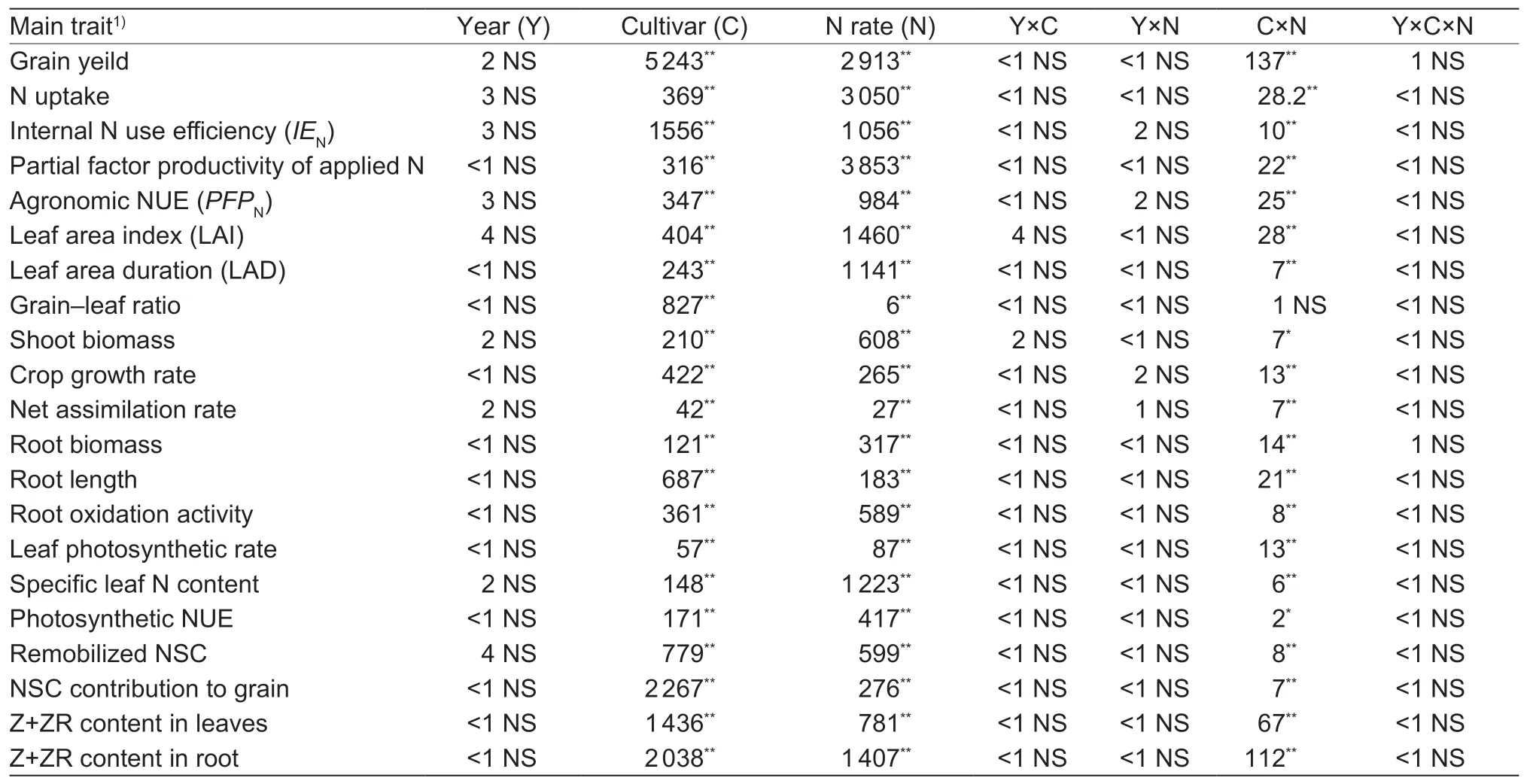
Table 1 Analysis of variance of grain yield,nitrogen use efficiency (NUE),and the main agronomic and physiological traits of rice between or among years,cultivars,and N rates
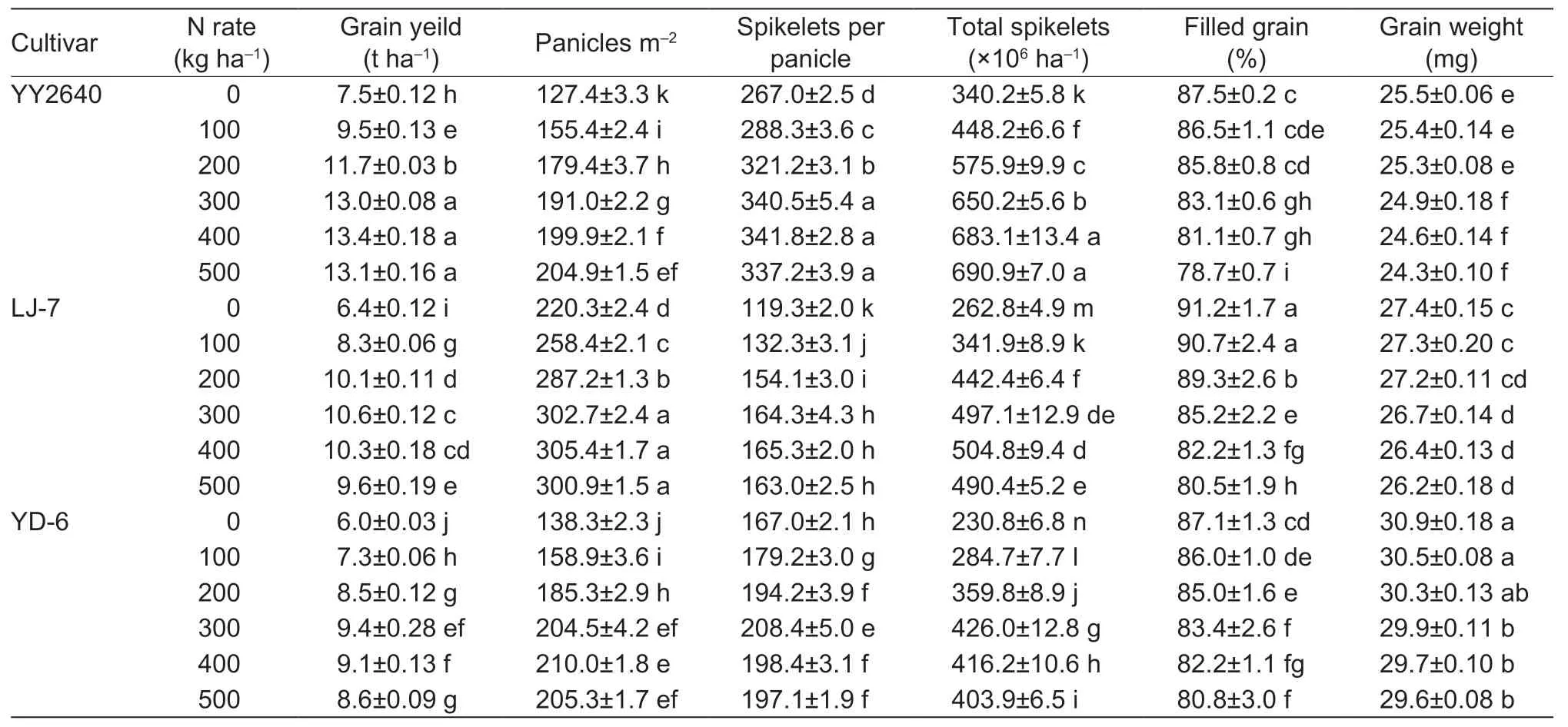
Table 2 Grain yield and its components under different nitrogen rates
3.3.Plant N uptake,N accumulation,and NUE
Changes in plant N uptake at different growth stages of the three test cultivars showed a similar trend,and the N uptake increased with the increase in N application rates and with the plant growth process (Fig.1-A–D).Under the same N rate and at the same growth stage,the plant N uptake of YY2640 was higher than that of either LJ-7 or YD-6 (Fig.1-A–D).The plant N accumulation of the three cultivars also increased with the increase in N application rates,but varied with growth stages (Fig.1-E–G).It first increased and then decreased with the growth process,and reached the maximum from panicle initiation to heading.Generally,the IJHR cultivar YY2640 accumulated more N in the plants than thejaponicainbred LJ-7 orindicainbred YD-6 at the same N rate and during the same growth period,especially from heading to maturity (Fig.1-E–G).
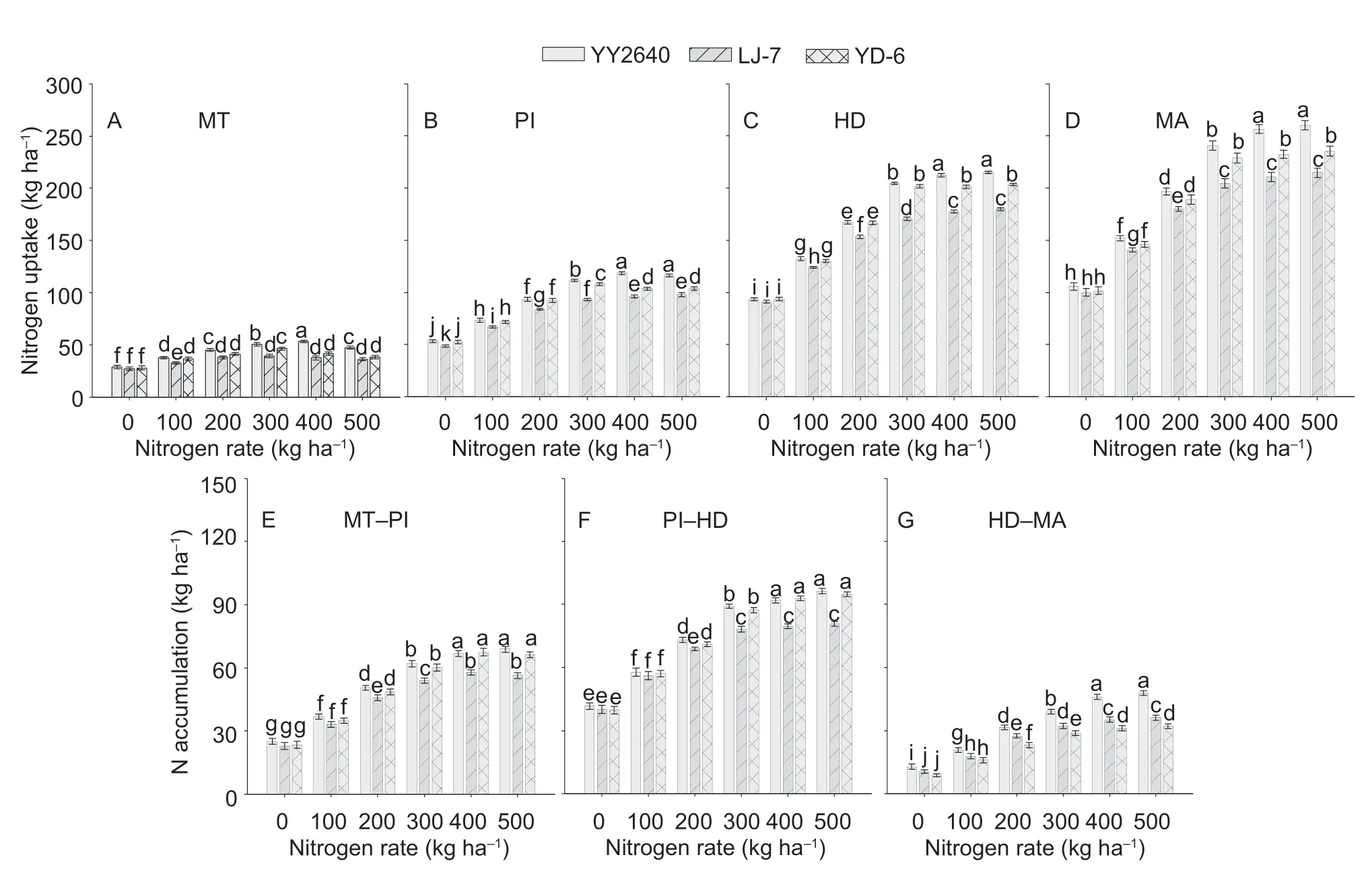
Fig.1 Differences in nitrogen (N) uptake (A–D) and N accumulation (E–G) during the main growth stages of rice under various N application rates.MT,PI,HD and MA represent mid-tillering,panicle initiation,heading,and maturity,respectively.Vertical bars represent standard deviations of the mean where these exceed the size of the symbol (n=6).Data are presented as the averages of the two study years.Different letters above the columns indicate statistical significance at the P=0.05 level within the same measurement date.
With the increase in N application rates,internal N use efficiency (IEN),partial factor productivity of applied N (PFPN),physiological N use efficiency (PEN),recovery efficiency of N fertilizer (REN),agronomic N use efficiency(AEN) and N harvest index (HIN) all decreased for all of the test cultivars (Table 3).There were no significant differences inAENorPENbetween YY2640 and LJ-7 at the N rates of 100 and 200 kg ha–1,while YY2640 showed greaterAENandPENthan LJ-7 at the N rates of 300,400 and 500 kg ha–1.At the same N rate,YY2640 always showed higherIEN,PFPN,PEN,REN,AEN,andHINwhen compared with YD-6,and higherIEN,PFPN,REN,andHINin comparison with LJ-7 (Table 3).
3.4.Shoot physiological traits
The total leaf area index (LAI,the LAI of total tillers and main stems) at heading,the LAI of productive tillers and main stems at heading,and LAI at maturity increased with the increase in N application rates (Table 4).Values of LAI were higher for YY2640 than for LJ-7 or YD-6 at the same N rate.Similar observations were obtained for the leaf area duration (LAD) from mid-tillering to panicle initiation,from panicle initiation to heading and from heading to maturity (Table 4).
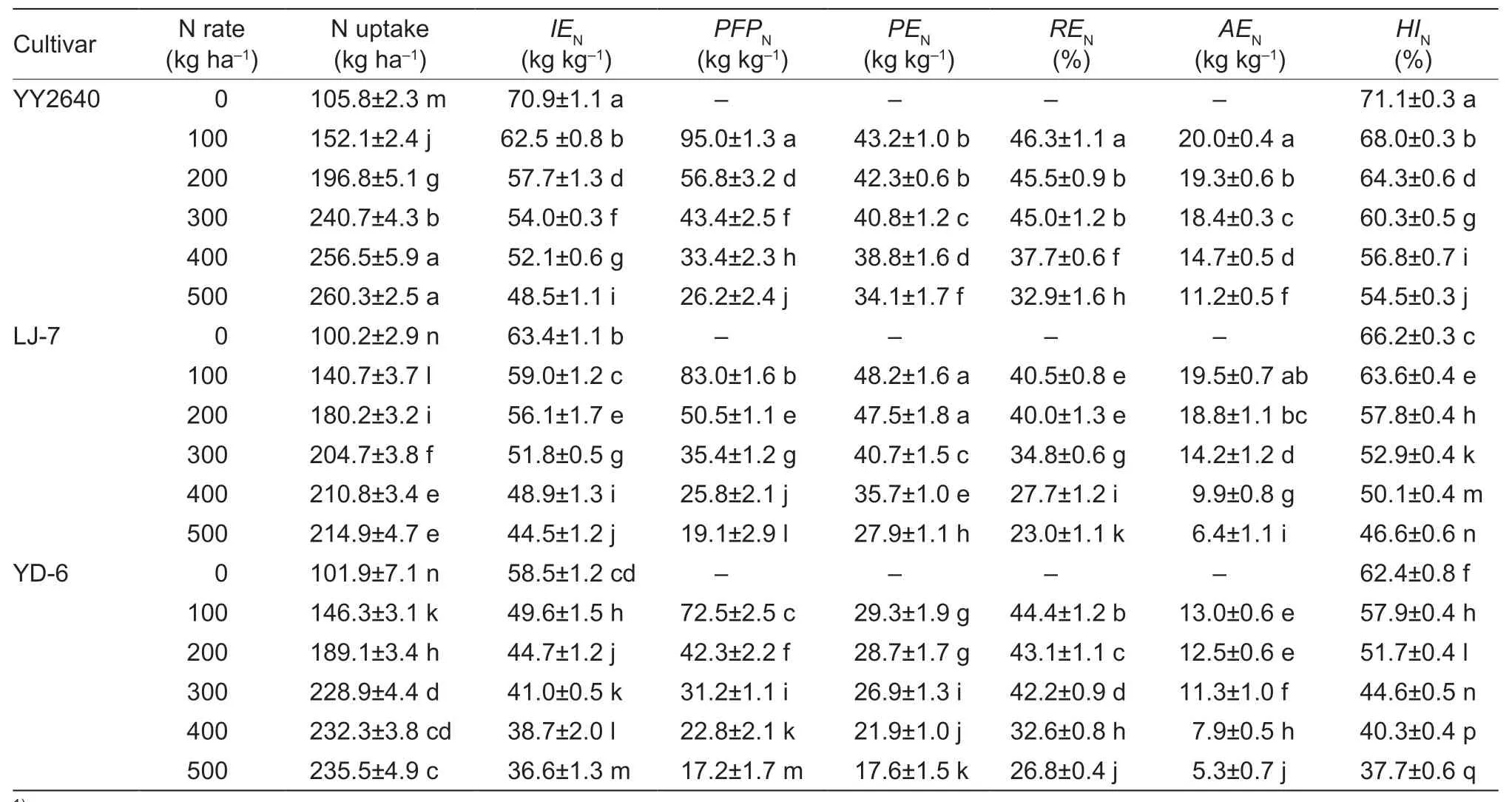
Table 3 Nitrogen uptake and N use efficiency under different N rates1)

Table 4 Leaf area index (LAI) and leaf area duration (LAD) of rice under different nitrogen rates1)
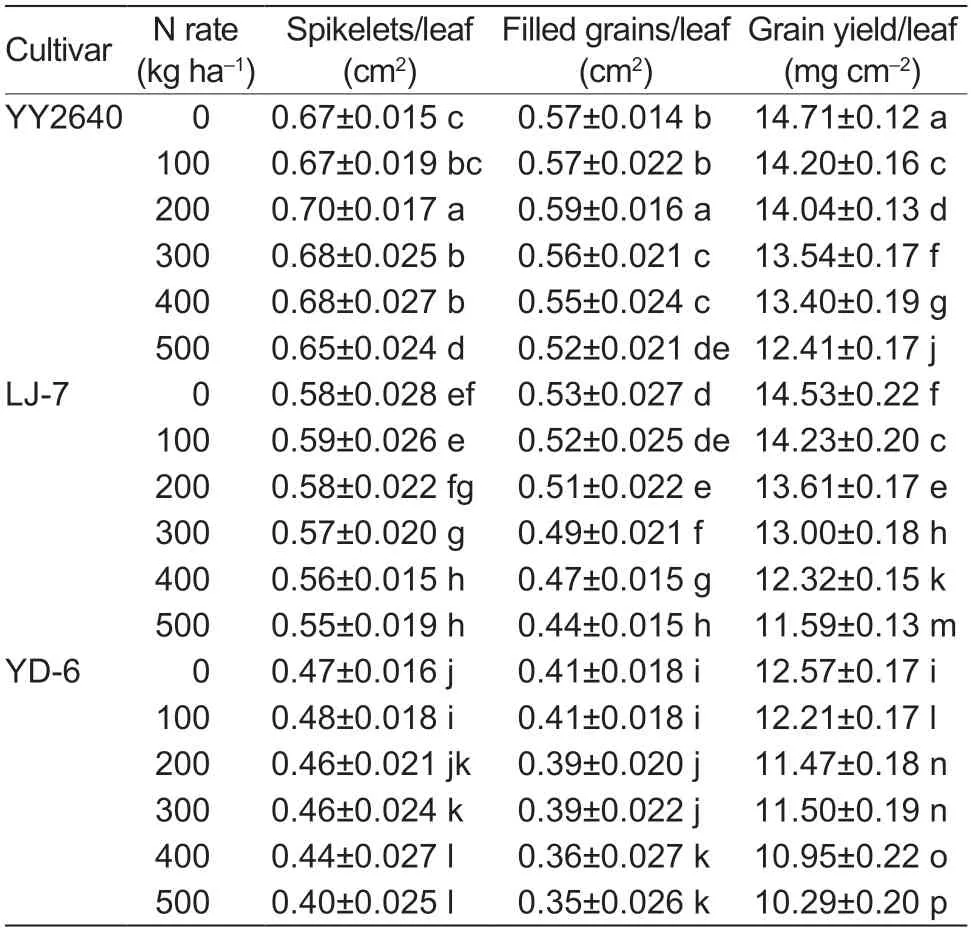
Table 5 Grain-leaf ratios of rice under different nitrogen rates1)
The grain-leaf ratios,in terms of spikelets/leaf area,filled grains/leaf area and grain yield/leaf area of YY2640 were significantly higher than those of LJ-7 or YD-6 under the same N rate (Table 5).The spikelets/leaf area and filled grains/leaf area of YY2640 and the spikelets/leaf area of LJ-7and YD-6 first increased and then decreased with the increase in N application rates,and reached their maxima at the N rate of 200 kg ha–1for YY2640 and at 100 kg ha–1for both check cultivars (LJ-7 and YD-6).The grain yield/leaf area of YY2640 and the filled grains/leaf area and grain yield/leaf area of LJ-7 and YD-6 decreased with the increase in N application rates (Table 5).
At the same N rate,shoot biomass was significantly higher for YY2640 than for LJ-7 or YD-6 (Fig.2-A–D).With the increase in N application rates,the shoot biomasses of the three cultivars also increased.Similar changing patterns were observed on both crop growth rate (CGR) and net assimilation rate (NAR) (Fig.2-E–J),implying that higher CGR and NAR contribute to a greater biomass for the IJHR cultivar.
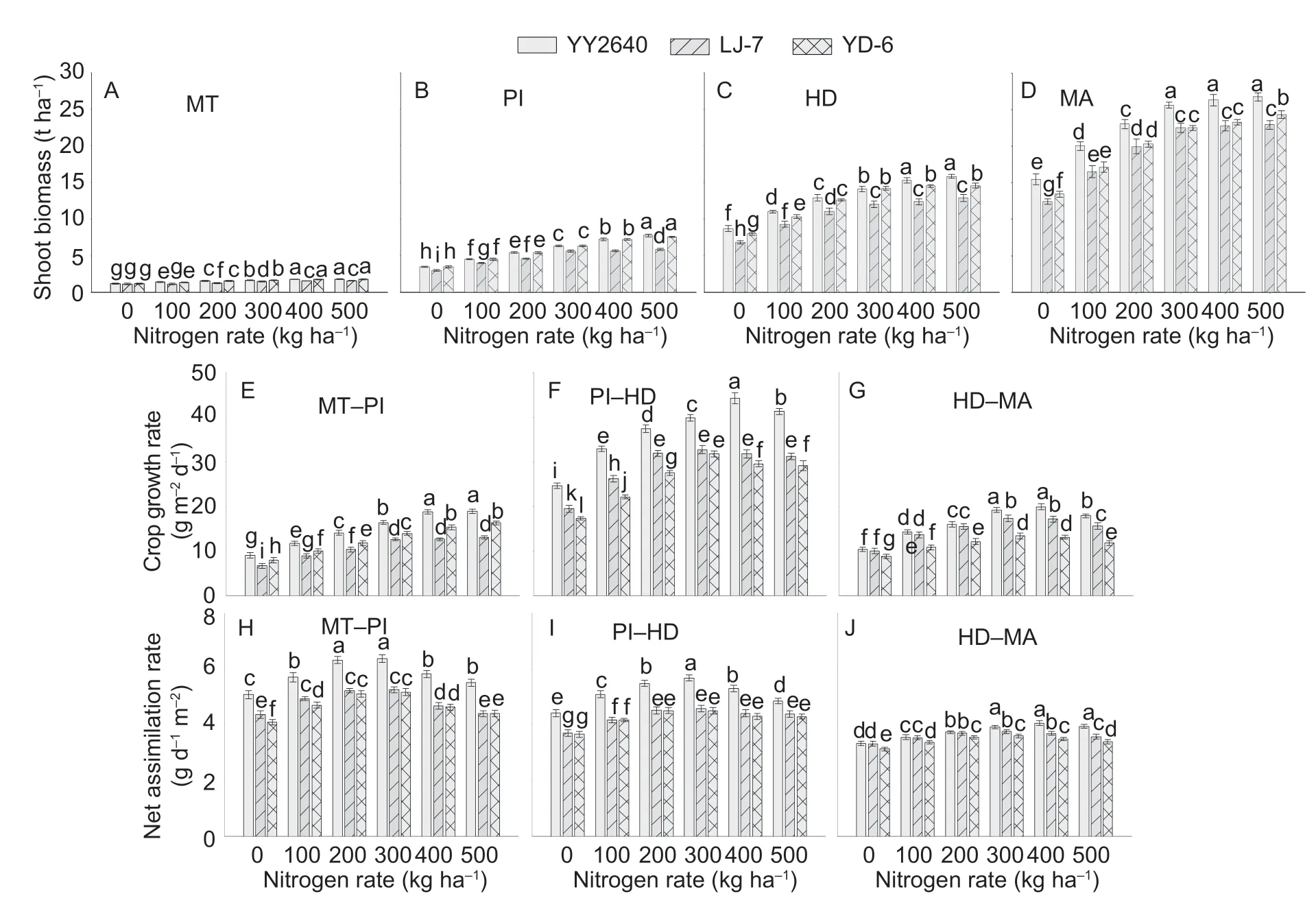
Fig.2 Shoot biomass (A–D),crop growth rate (E–G),and net assimilation rate (H–J) of rice under various nitrogen rates.MT,PI,HD and MA represent mid-tillering,panicle initiation,heading,and maturity,respectively.Vertical bars represent standard deviations of the mean where these exceed the size of the symbol.Data are presented as the averages of the two study years.Different letters above the columns indicate statistical significance at the P=0.05 level within the same measurement date.
The photosynthetic rates of the three cultivars significantly increased with the increase in N application rates from panicle initiation to late grain filling,but they showed no significant difference under the rates of 300,400 and 500 kg ha–1(Table 6).YY2640 showed a higher photosynthetic rate than LJ-7 or YD-6 at the same N rate,suggesting that the IJHR cultivar has a higher photosynthetic ability than the inbred rice cultivars at the middle and late growth stages,especially under high N rates.

Table 6 Leaf photosynthetic rate (μmol CO2 m–2 s–1) of rice under different nitrogen rates
When the N application rate was lower than 400 kg ha–1,the specific leaf N contents of the three cultivars increased with the increase in N application rates.When the N application rate exceeded 400 kg ha–1,increasing N application rates did not significantly increase specific leaf N contents of any of the test cultivars (Table 7).At the same N rate,the specific leaf N content of YY2640 was significantly higher than that of LJ-7,and showed no significant difference from that of YD-6 at panicle initiation,but was lower than that of YD-6 at the heading time (Table 7).The photosynthetic NUE of the three cultivars decreased with the increase in N application rates at panicle initiation and heading time (Table 7).At the same N rate,photosynthetic NUE of YY2640 was significantly higher than that of YD-6 at panicle initiation,and exhibited no significant difference from that of LJ-7 at panicle initiation,but was higher than those of both check cultivars at the heading time (Table 7).
When the N application rate was less than 400 kg ha–1for YY2640 and less than 300 kg ha–1for LJ-7 and YD-6,the contents of zeatin (Z)+zeatin riboside (ZR) in leaves increased with the increase in N application rates(Fig.3-A–E).When the N application rate exceeded 400 kg ha–1for YY2640 and was more than 300 kg ha–1for LJ-7 and YD-6,an increase in N application did not significantly decrease the Z+ZR content in leaves of YY2640,while it significantly decreased the Z+ZR content in leaves of both check cultivars.Under the same N application rate,YY2640 produced higher Z+ZR content in leaves than either LJ-7 or YD-6 (Fig.3-A–E).
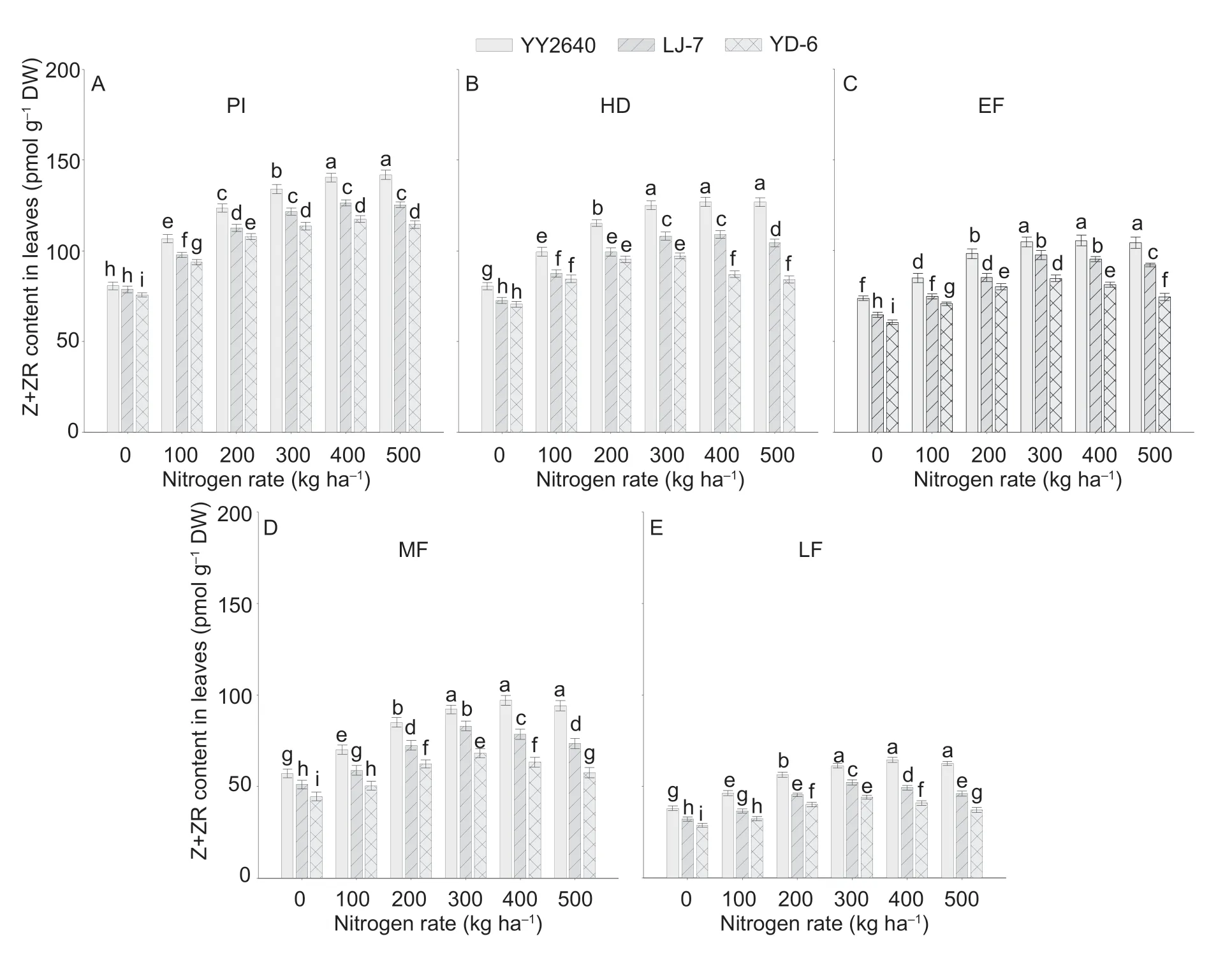
Fig.3 Zeatin+zeatin riboside (Z+ZR) contents in the leaves of rice under various nitrogen rates.PI,HD,EF,MF and LF represent panicle initiation,heading,early grain filling,mid grain filling,and late grain filling,respectively.Vertical bars represent ±standard deviations of the mean where these exceed the size of the symbol (n=6).Data are presented as the averages of the two study years.Different letters above the columns indicate statistical significance at the P=0.05 level within the same measurement date.
In general,NSC accumulation in the stems (culms and sheaths) at the heading time and maturity,and the amount of NSC translocation during grain filling,increased at first and then were decreased with the increase in N application rates,and reached the maxima at the N rate of 400 kg ha–1for YY2640 and at 300 kg ha–1for LJ-7 and YD-6 (Table 8).However,the NSC remobilized from the stems and the NSC contributed to grain yield during the grain-filling period both decreased with increases in N application rates for all the test cultivars.At the same N application rate,YY2640 exhibited higher NSC accumulation in the stems,more remobilization of NSC from stems to grains,and a greater contribution of NSC to grain yield than both check cultivars (Table 8).

Table 7 Photosynthetic nitrogen use efficiency (NUE) of rice under different N rates1)
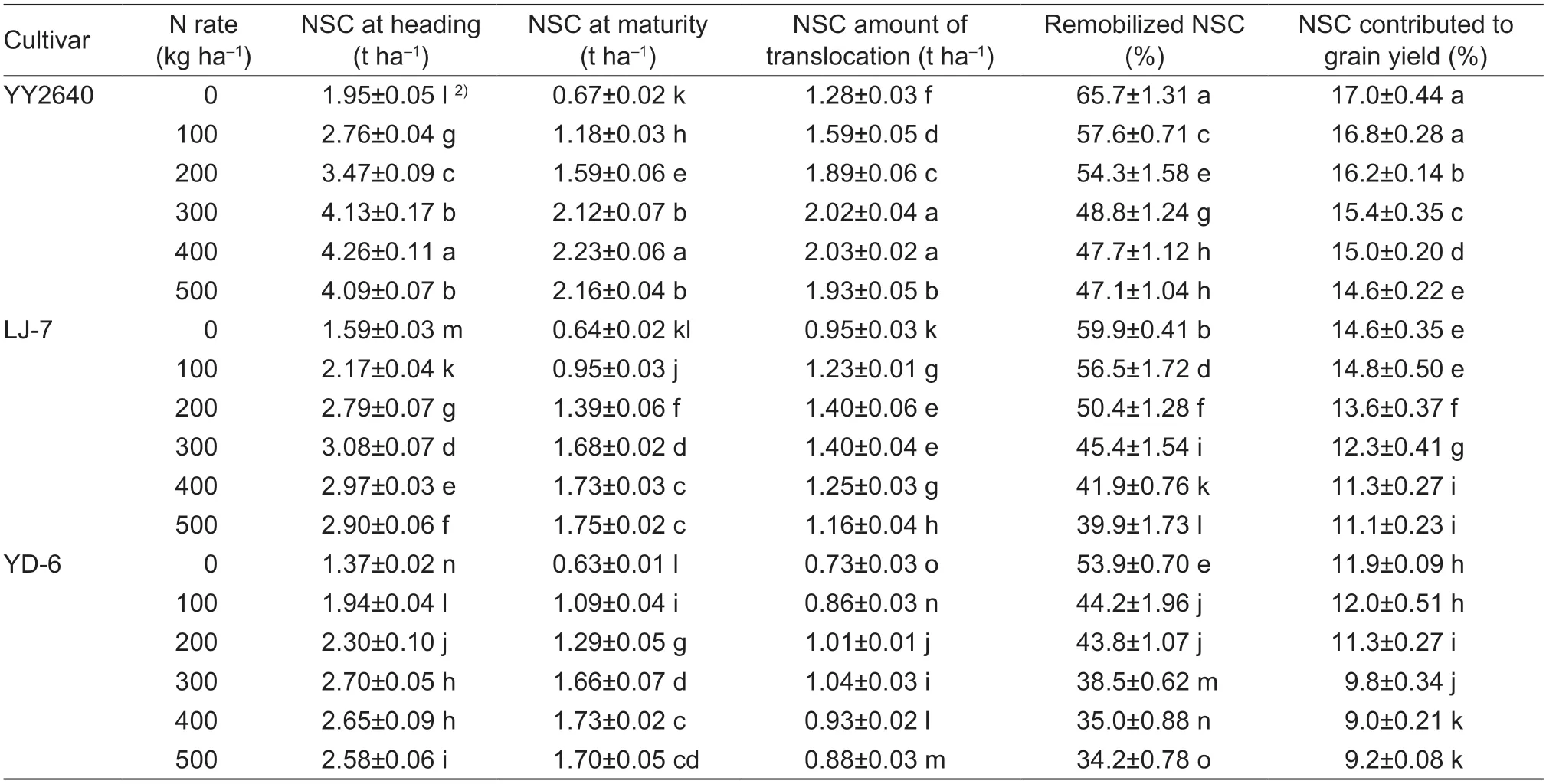
Table 8 Non-structural carbohydrate (NSC) in stems and sheaths,and NSC remobilization of rice under different nitrogen rates1)
3.5.Root morpho-physiological traits
Overall,the root length and root biomass increased with the increase in N application rates (Fig.4-A–H).At the same N rate,YY2640 had greater root length and root biomass than LJ-7 or YD-6 at each growth stage.However,the ratio of root to shoot decreased with the increase in N application rates for all the test cultivars at each growth stage,and showed no significant differences among the three cultivars (Fig.4-I–L),suggesting that agreater shoot biomass is closely associated with a greater root biomass for the IJHR.

Fig.4 Root length (A–D),root biomass (E–H),and the ratio of root to shoot (I–L) of rice under various nitrogen rates.MT,PI,HD and MA represent mid-tillering,panicle initiation,heading,and maturity,respectively.Vertical bars represent standard deviations of the mean where these exceed the size of the symbol (n=6).Data are presented as the averages of the two study years.Different letters above the columns indicate statistical significance at the P=0.05 level within the same measurement date.
Consistent with the root biomass,the root oxidation activity (ROA) and Z+ZR content in the roots increased with increases in N application rates for the three test cultivars at each growth stage (Fig.5-A–H).At the same N rate,YY2640 had higher ROA and Z+ZR content in roots than LJ-7 or YD-6,especially at the heading time and during grain filling,indicating the stronger root activity of the IJHR cultivar.
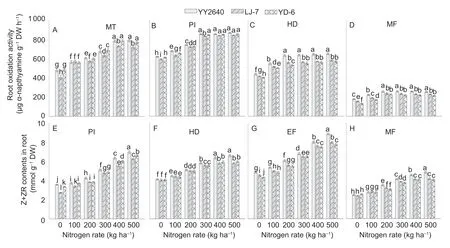
Fig.5 Root oxidation activity (A–D) and zeatin+zeatin riboside (Z+ZR) contents in roots (E–H) of rice under various nitrogen rates.MT,PI,HD,EF and MF represent mid-tillering,panicle initiation,heading,early grain filling and mid grain filling,respectively.Vertical bars represent standard deviations of the mean where these exceed the size of the symbol (n=6).Data are presented as the averages of the two study years.Different letters above the columns indicate statistical significance at the P=0.05 level within the same measurement date.
3.6.Correlations of shoot and root traits with grain yield and NUE
Pearson correlation analysis showed that high-effective LAI,effective LAI and total LAI at heading time,root and shoot biomass from heading to maturity,CGR and NAR before heading time,leaf photosynthetic rate during grain filling,root length,and ROA and Z+ZR content in roots and leaves during panicle initiation and grain filling were all significantly and positively correlated with the total spikelet number and grain yield (Fig.6).The ROA during panicle initiation and grain filling was significantly and positively correlated with the contents of Z+ZR in both roots and leaves.Contents of Z+ZR in leaves and roots,ROA,root length,LAD,CGR,NAR and leaf photosynthetic rate during grain filling were significantly and positively correlated with root and shoot biomass,grain yield,recovery efficiency of N fertilizer (REN) and agronomic N use efficiency (AEN).The photosynthetic NUE values were significantly and positively correlated with filled grain percentage,filled grains/leaf area,grain yield/leaf area,remobilized NSC reserve,and internal nitrogen use efficiency (IEN) (Fig.6).
4.Discussion
It is generally believed that IJHR has a greater capacity for biomass production and greater yield potential when compared with eitherindicaorjaponicainbred rice,and it usually absorbs more N and has a lower NUE than inbred rice (Weiet al.2016,2017;Guet al.2017).The results herein showed that the IJHR cultivar YY2640 exhibited both higher grain yield and higher NUE than either thejaponicainbred or theindicainbred cultivar when the N application rate was the same,especially at a higher N rate (Tables 2 and 3).These results demonstrate that the IJHR cultivar could not only exhibit greater yield potential,but also efficiently use absorbed N to produce more grain yield,leading to a higher NUE,such asIEN.
Prior to this study,the information about the synergistic improvement in grain yield and NUE in IJHR was rather limited.Our observations in the present study provide several possible explanations for the synergistic improvement.Firstly,the IJHR cultivar YY2640 exhibited a larger sink size (total number of spikelets per unit area)and a higher ratio of sink size to leaf area (spikelets/leaf area) (Tables 2 and 5).A larger sink size is necessary to achieve a higher grain yield (Katoet al.2007;Penget al.2009),while a higher ratio of sink size to leaf area could make plants expend more N to produce productive organs(spikelets) and less N to produce vegetative organs(leaves),leading to higher NUE (Xueet al.2013;Zhang Het al.2021).We observed that the IJHR cultivar absorbed more N during panicle differentiation and development,which may contribute to its larger sink size and higher ratio of sink size to leaf area (Fig.1).
Secondly,the IJHR cultivar YY2640 showed stronger shoot activity,which was reflected by its larger LAI and LAD,and higher CGR,NAR,and leaf photosynthetic rate than the inbred cultivars at the same N application rate(Fig.2;Tables 4 and 6).Larger LAI and LAD are very important for producing more biomass and increasing sink size (Liuet al.2014;Huanget al.2019;Zhanget al.2019;Zhang Het al.2021).Higher CGR,NAR,and leaf photosynthetic rate can invest less N in producing more biomass and grain yield (Horieet al.2005;Fageria 2007;Xueet al.2013;Zhang Het al.2021),which is also evidenced by our observations that the IJHR cultivar had higher photosynthetic NUE (Table 7).It is proposed that a higher photosynthetic NUE can invest less N in nonphotosynthetic components and more N in dry mater production,which can contribute to a higher NUE (Juet al.2015;Wanget al.2016),and photosynthetic NUE was observed in the present study to be significantly and positively correlated withIEN(Fig.6).
Thirdly,the IJHR cultivar accumulated more NSC in stems including sheaths before heading and remobilized more NSC from the stem to the grain during grain filling than the inbred rice cultivars (Table 8).Some reports show that more accumulation of NSC in rice stems before heading could enhance sink activity,such as increases in the activities of key enzymes involved in sucrose-to-starch conversion in the grain at the early grain-filling stage,and more NSC remobilization from the stem to the grain during ripening could provide more carbohydrates for grain filling and increase the harvest index and N harvest index,all of which could result in the improvement of grain filling efficiency and NUE (Fuet al.2011;Zhanget al.2013;Okamuraet al.2018;Zhang Het al.2021).
Fourthly,the IJHR had better root morpho-physiological traits,which were evidenced by its greater root length and biomass and higher ROA in comparison with inbred rice(Figs.4 and 5).A greater root length and root biomass could allow the plants to absorb more water and nutrients from the soil and thereby ensure shoot growth (Zhanget al.2009;Yanget al.2012;Menget al.2018).A higher ROA has been recognized as the most important physiological trait and is vitally important to maintaining root growth and achieving higher shoot activity (Osakiet al.1997;Yanget al.2012;Chuet al.2014;Menget al.2018).Root length,root biomass,and ROA were herein found to be closely associated with grain yield and NUE(Fig.6).
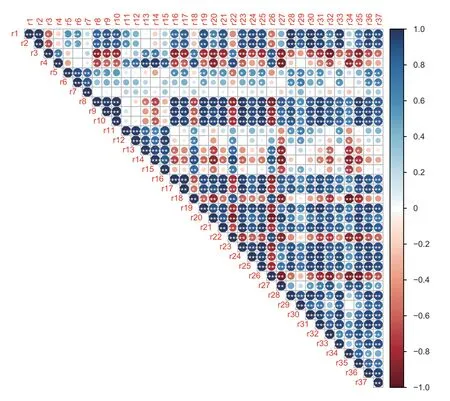
Fig.6 Pearson correlations of agronomic and physiological traits with grain yield,yield components,and nitrogen use efficiency of rice.r1,grain yield;r2,total spikelets;r3,filled grain;r4,internal N use efficiency;r5,recovery efficiency of N fertilizer;r6,agronomic N use efficiency;r7,partial factor productivity of applied N;r8,total leaf area index (LAI);r9,high-effective LAI;r10,effective LAI;r11,no.of total spikelets/leaf;r12,no.of filled grains/leaf;r13,grain weight/leaf;r14,remobilized non-structural carbohydrate (NSC)reserve;r15,NSC contribution to grain;r16,shoot dry weight at heading time (HT);r17,root dry weight at HT;r18,root:shoot ratio at HT;r19,root length at HT;r20,specific leaf N content (SLNC) at HT;r21,leaf photosynthetic rate at HT;r22,photosynthetic N use efficiency (PNUE) at HT;r23,shoot dry weight at maturity (MA);r24,shoot biomass from HT to MA;r25,root dry weight at MA;r26,root:shoot ratio at MA;r27,LAD;r28,CGR;r29,net assimilation rare (NAR);r30,leaf photosynthetic rate during grain filling;r31,zeatin+zeatin riboside (Z+ZR) contents in leaves at panicle initiation (PI);r32,Z+ZR contents in roots at PI;r33,Z+ZR contents in leaves during grain filling;r34,Z+ZR contents in roots during grain filling;r35,root oxidation activity (ROA) at PI;r36,ROA at HT;r37,ROA during grain filling.The red and blue circles indicate negative or positive correlations between parameters,respectively.The darker the color,the higher the correlation.*,** and *** indicate the significant differences at the P<0.05,P<0.01 and P<0.001 levels,respectively.For interpretation of the references to colour in this figure legend,the reader is referred to the web version of this article.
Furthermore,the IJHR cultivar exhibited higher cytokinin (Z+ZR) contents in both roots and leaves(Figs.3 and 5).A higher Z+ZR content in plants during panicle differentiation and development could promote spikelet differentiation and increase spikelet number per panicle,and the Z+ZR content in rice caryopses during filling is significantly and positively correlated with the endosperm cell proliferation rate and grain-filling rate,and consequently,results in the increases in sink size and activity and grain yield (Yanget al.2000,2002;Kyozuka 2007;Xuet al.2015).It is proposed that there is a tight linkage between the N signaling network and cytokinin metabolism and signaling (Guet al.2018).Greater N uptake or assimilation can enhance cytokinin biosynthesis,and in turn,the increase in cytokinin biosynthesis can enhance N uptake and assimilation in plants and make the absorbed N produce more biomass,and accordingly,lead to a higher NUE (Yanget al.2012;Guet al.2018).
It is noteworthy that although a maximum grain yield was obtained at the N rate of 400 kg ha–1for the IJHR cultivar,the grain yield showed no significant difference among the N rates of 300,400,and 500 kg ha–1(Table 2).Furthermore,each index of NUE for the IJHR cultivar was significantly lower at the N rate (kg ha–1) of 400 or 500 that at the N rate at 300 (Table 3).Therefore,we suggest that the N application rate of 300 kg ha–1when the soil fertility is medium,such as the soil of the present experiment,or the specific leaf N content (g m–2) is approximately 3.4 and 2.9,respectively,at the panicle initiation and the heading time (Table 7),could be considered as a rational N application index to achieve both high grain yield and high NUE for the IJHR cultivar.
It should be also mentioned that the total growth durations of the three tested cultivars were around 155–157 d.Similar observations were reported by Zhanget al.(2020) and Liuet al.(2021).Generally,the growth duration of mid-season rice cultivars,such as Yangdao 6,in the lower reaches of the Yangtze River in China is approximately 145–150 d.The slightly longer growth durations of the three tested cultivars in the present study may mainly be attributed to the increase in temperature during the late grain-filling period in recent years (Wanget al.2021),which results in slower plant senescence and a longer grain-filling period.
To reduce the influence of non-treatment factors on the experimental results,the present study design used two seedlings per hill for all the tested cultivars at transplanting.Usually,more seedlings per hill are recommended for inbred rice than for hybrid rice because the tillering ability of the former is lower than that of the latter.Our results demonstrated,however,that panicle number per unit area was much greater for the inbred rice than for the IJHR at the same N rate (Table 2),indicating that both inbred rice cultivars have stronger tillering ability than the hybrid rice cultivar.Further investigation is merited to determine whether more than two seedlings per hill at transplanting could increase grain yield for inbred rice at N application rates of 200 or 300 kg ha–1.
5.Conclusion
The IJHR cultivar YY2640 produced much higher grain yield than inbred rice cultivars at the same N application rate,due mainly to its greater total number of spikelets per unit area which resulted from more spikelets per panicle.At the same N application rate and compared with inbred rice cultivars,the IJHR cultivar could not only absorb more N,but also efficiently utilize the absorbed N to produce more grain yield,leading to higherIEN,RENandAEN.Improved shoot and root traits of the IJHR cultivar,including LAI,LAD,CGR,NAR,grain–leaf ratio,leaf photosynthetic rate,photosynthetic NUE,the remobilization of NSC from stems,root length,root biomass,and ROA,contributed to its higher grain yield and NUE.The higher contents of Z+ZR in both roots and leaves of the IJHR played a vital role in its response to N application rates and benefited other physiological processes.An N application rate at 300 kg ha–1in the soil with medium-fertility,or specific leaf N content of approximately 3.4 and 2.9 g m–2,respectively,at the panicle initiation and the heading time,could be used as a rational N application index to achieve both high grain yield and high NUE for the IJHR cultivar.
Acknowledgements
We are grateful for grants from the National Natural Science Foundation of China (32071943),the Priority Academic Program Development of Jiangsu Higher Education Institutions,China (PAPD-2020-01),the Postgraduate Research and Innovation Program of Jiangsu Province,China (XKYCX17_052),and the Top Talent Supporting Program of Yangzhou University,China(2015-01).
Declaration of competing interest
The authors declare that they have no conflict of interest.
Appendicesassociated with this paper are available on http://www.ChinaAgriSci.com/V2/En/appendix.htm
杂志排行
Journal of Integrative Agriculture的其它文章
- Less hairy leaf 1,an RNaseH-like protein,regulates trichome formation in rice through auxin
- Characterization of a blaCTX-M-3,blaKPC-2 and blaTEM-1B co-producing lncN plasmid in Escherichia coli of chicken origin
- Consumers’ experiences and preferences for plant-based meat food: Evidence from a choice experiment in four cities of China
- Farmers’ precision pesticide technology adoption and its influencing factors: Evidence from apple production areas in China
- Visual learning graph convolution for multi-grained orange quality grading
- lnfluence of two-stage harvesting on the properties of cold-pressed rapeseed (Brassica napus L.) oils
